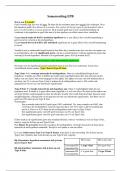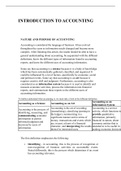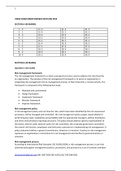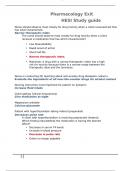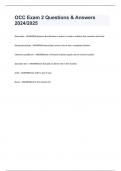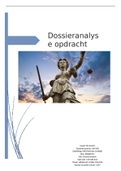CONSORT 2010 statement: Updated guidelines for reporting parallel group
randomised trials. Schulz, K.F., Altman, D.G., & Moher, D. (2010)
Randomised controlled trials represent the gold standard. However, they can yield biased results if
they lack methodological rigour. Authors of many trial reports neglect to provide lucid and complete
descriptions of the critical information necessary to be able to assess a trial accurately as a reader.
This lead to the development of the CONSORT (Consolidated Standards of Reporting Trials)
statement. However, this statement also needs an update which was tried in 2010.
Intent of CONSORT 2010
CONSORT 2010 provides guidance for reporting all randomised controlled trials. Adherence by
authors to the checklist items facilitates clarity, completeness and transparency of reporting. Note
that the CONSORT 2010 statement does not include recommendations for designing, conducting and
analysing trials. It solely addresses the reporting of what was done and what was found. Thus,
CONSORT 2010 is not intended as an instrument to evaluate the quality of a trial.
Nevertheless, CONSORT does indirectly affect design and conduct. Transparent reporting reveals
deficiencies in research if they exist. Thus, a trial’s inadequacies should be revealed in this process.
Furthermore, CONSORT can help researchers in designing their trial. CONSORT seems to improve
reporting.
Implications and limitations
CONSORT 2010 was developed in order to assist authors in writing reports of randomised controlled
trials, editors and peer reviewers in reviewing manuscripts for publication, and readers in critically
appraising published articles. CONSORT focuses predominantly on the two group, parallel
randomised controlled trial. The evidence based approach used for CONSORT also served as a model
for the development of other reporting guidelines. The explicit goal of all these is to improve
reporting.
However, as a potential drawback, a reporting guideline might encourage some authors to report
fictitiously the information suggested by the guidance rather than what was actually done.
,Evidence-based psychosocial treatments for phobic and anxiety disorders in children
and adolescents. Silverman, W., Pina, A., & Viswesvaran, C. (2008)
Classification of psychosocial treatment studies based on Nathan/Gorman’s (2002) criteria
Nathan and Gorman’s (2002) criteria specify six types of treatment studies. Type 1 studies are the
most rigorous and involve randomised, prospective clinical trial methodology. Type 2 studies are
clinical trials in which an intervention is tested but at least one aspect of the Type 1 study
requirement is missing. Type 3 studies are methodologically limited. They are open trials aimed at
obtaining pilot data and are thereby subject to observer bias, but they still indicate whether the
treatment would be worth pursuing using a more rigorous design. Type 4 studies are reviews with
secondary data analyses such as meta-analyses. Type 5 studies are reviews that do not include
secondary data analyses, and Type 6 studies are case studies, essays and opinion papers.
Classification of psychosocial treatments based on Chambless et al. (1996), and Chambless
and Hollon (1998)
Criteria from Chambless et al. (1996) and Chambless and Hollon (1998) were used to determine each
treatment’s classification within one of the following categories: well-established treatments,
probably efficacious treatments, possibly efficacious treatments, and experimental treatments.
Probably efficacious psychosocial treatments
Individual cognitive behaviour therapy
Youth in ICBT received a treatment package which included recognising/clarifying distorted
cognitions and attributions, devising coping plans, and evaluating performance. The behavioural
component of the treatment included in vivo exposures, relaxation training, and contingent
reinforcement. Although it was not possible to control for any subsequent treatment the youth
might have received, rendering it unclear whether ICBT was the primary source of change, prognoses
were positive. Posttreatment gains were maintained at long-term follow-up. In addition, successful
outcome at posttreatment was linked to less substance use at long-term follow-up, suggesting
potential preventive value of early intervention.
Group cognitive behaviour therapy
Hierarchical linear modelling showed continued improvement on all rating scales from posttreatment
to 3-month follow-up, with continued maintenance of treatment gains over 6- and 12-month follow-
up.
Comparing ICBT and GCBT, at posttreatment, ICBT had a 73% primary/targeted diagnostic recovery
rate and GCBT had a 50% primary/targeted diagnostic recovery rate, a nonsignificant difference. In
bibliotherapy, parents are provided with a commercially available book and children with a workbook
containing parallel information. Although perhaps better than no treatment, this type of treatment
does not meet the same level of efficacy as GCBT.
GCBT for SOP
In a girls-only study, GCBT was less robust in this study than in other studies. The authors suggest
that the girls’ heterosocial anxiety, which was not a direct target of treatment, may have played a
role, and that the girls’ SOP may have been complicated by episodes of major depression.
In one GCBT study, no statistically significant improvements were found from pre- to posttreatment,
but significant improvements were found from pre-treatment to 3-month follow-up. These lagged
effects suggest the interesting possibility that children may benefit from an extended time interval in
, which they can practice and consolidate the skills learned in treatment, especially when there are
few treatment sessions.
Social effectiveness training for children (SET-C)
At posttreatment, 67% in SET-C no longer met criteria for SOP.
Possibly efficacious psychosocial treatments
ICBT with parents
The treatment condition showed improvement. Significant differences were found between ICBT and
ICBT with parents on diagnostic recovery rates. At 1-year follow-up, ICBT with parents was
statistically significantly superior. However, other studies found no significant difference between
with or without parents.
More on this in the article, but I doubt whether the details are really necessary.
Mediators, moderators and predictors of treatment outcome
Changes in anxious self-talk may mediate symptom reduction. In one study, younger children
responded significantly better than older children to ICBT plus FAM than to ICBT, as did girls relative
to boys.
Several studies have explored for predictors of treatment outcome – that is, variables accounting for
outcome irrespective of treatment condition. Parents’ depressive symptoms on the BDI were the
strongest predictor of youths’ poor treatment response. Furthermore, parental fear and hostility also
were significant predictors of poor treatment response. Family dysfunction may also be a predictor.

